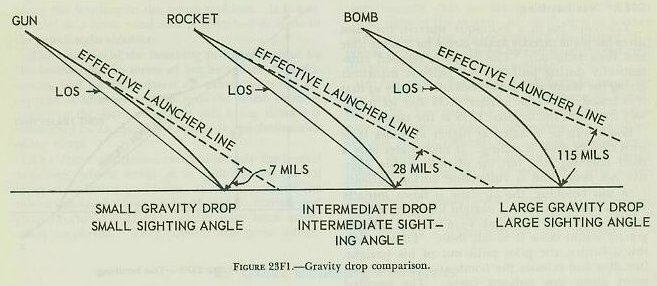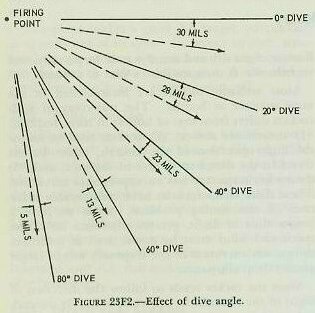| NAVAL ORDNANCE AND GUNNERY, VOLUME 2 CHAPTER 23 AIRCRAFT FIRE CONTROL |
| HOME INDEX Chapter 23 Aircraft fire control A. Introduction B. Aircraft gunnery C. Aircraft weapon systems D. Theory of horizontal bombing E. Other bombing problems F. Rocketry |
| F. Rocketry 23F1. General The problem of how to aim and fire rockets from aircraft is considerably more complicated than that of aiming and firing bullets. The complications stem mainly from the ballistics of rockets, and from the method of launching them. The two are closely related, since the rocketís trajectory depends on the way in which it is launched as well as upon other factors. 23F2. Launching airborne rockets The motion of a rocket can be divided into three distinct periods: the launching period, the period of burning after launching, and the period of motion after burning is over. During the launching period, the rocket is under the influence of the aircraft that carries it. During the burning period, the rocket is subjected to the force of gravity, jet forces, and aerodynamic forces. After the rocket fuel is consumed, the rocket moves under the influence of gravity and aerodynamic forces only, and its behavior is then similar to that of a bomb. Most airborne rockets are fin-stabilized in the same manner as bombs. The trajectory of such rockets differs from that of bullets in three respects: (1) rockets are slower; (2) rockets tend to follow the flight direction of the aircraft, while bullets travel in the direction of aim of the gun: and, (3) the rocket trajectory has an appreciable curvature. These three characteristics have considerable influence on the aiming problem. Since we have a longer time of flight, greater allowance for target speed and wind must be made; and, in addition, the greater curvature of the trajectory means larger gravity drop allowance. Since the rocket tends to follow the direction of flight of the aircraft, its trajectory is highly dependent on the manner in which it is launched. Thus the launching device, the method of stabilization (whether fin- or spin-stabilized), and the attitude of the aircraft at the instant of launching, all contribute to the aiming problem. 23F3. Factors affecting rocket trajectory Three factors strongly affect the trajectory of rockets: gravity, dive angle, and launching speed. |
 |
 |
 |
| Figure 23F1 shows the difference in magnitude of the gravity drop effect for shell fire, rocket fire, and bomb dropping; it illustrates the intermediate role of the rocket. Figure 23F2 shows the effect of the dive angle on the trajectory drop, and illustrates the fact that the trajectory drop decreases as the dive angle increases. Trajectory drop is the angle between the effective launching line and the line of sight at the point of release. Figure 23F3 shows the effect of launching speeds on the rocket trajectory, and illustrates the fact that the greater the speed the smaller the trajectory drop. |